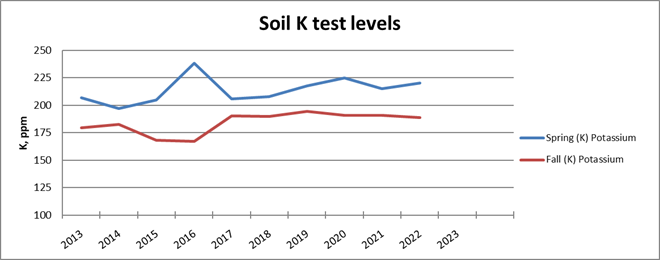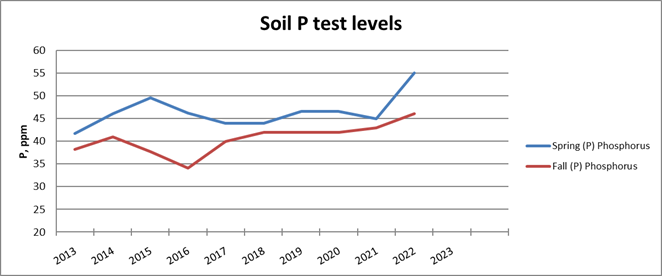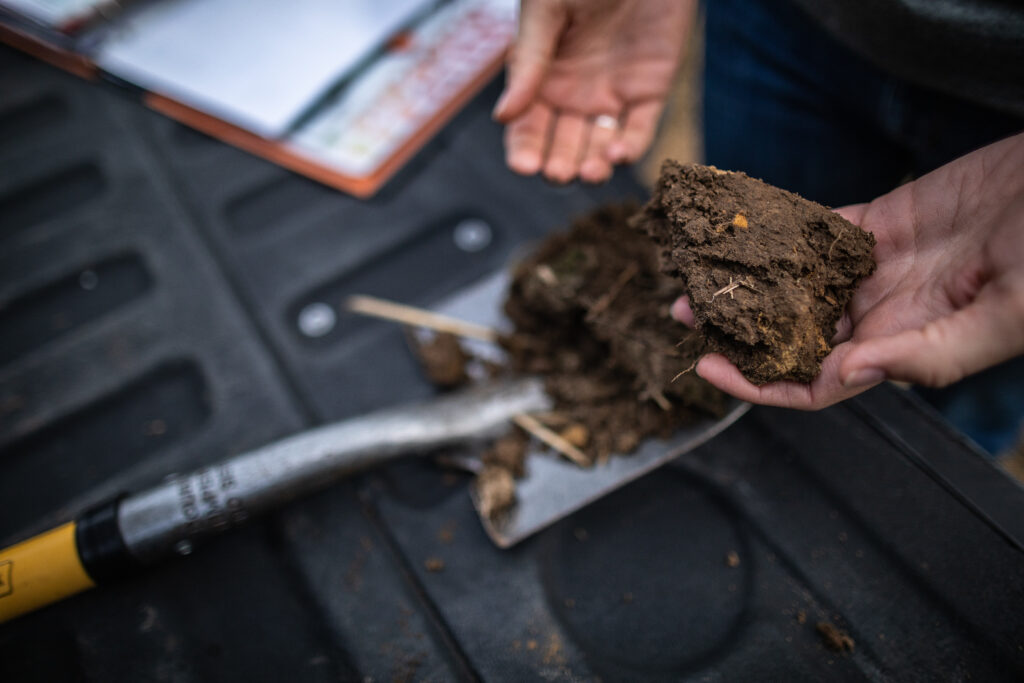How are dry weather conditions affecting soil fertility?
For the best viewing experience, please view this article on a desktop computer.
Soil fertility is uncertain this year after unusually dry conditions swept across the region. With season-long drought conditions, concerns arise about nutrient removal rates due to lower yields, availability of residual nutrients and the impact on soil test results. Additionally, pulling soil samples in dry conditions presents its own challenge, as has been seen in recent years.
P and K removal from lower yields
We apply fertilizer to build soil fertility to target levels, then maintain it by replacing the nutrients that are taken off the field during harvest. When yields are lower than anticipated however, there may be leftover phosphate and potash due to lower crop uptake. Those residual nutrients can be credited to the next crop and deducted from that year’s fertilizer plan.
In other instances, though, cutting back on fertilizer might not be the best approach. If the yield of corn is low due to late season drought conditions limiting grain development, it is possible that the nutrient uptake during the growing season was high, but removal in the grain is lower than expected. In this case, removal of nutrients from the field might be lower, but nutrient uptake in the leaves and stalk are retained and will soon return to the soil through leaching and decomposition. In this case, cutting back on the following year’s fertilizer application because of lower yield wouldn’t be advised.
Nutrient availability in the soil
Nutrient uptake from the soil is driven by demand as the crop grows and is influenced by soil moisture. Crops use the most readily available forms of P and K from the soil solution first, and then the less available forms are released into the soil solution for uptake by plants. During the growing season, the concentration of nutrients in the soil is controlled by the dissolving fertilizer, exchange from clays and minerals and release from decaying organic material.
Fall soil test levels are typically lower than spring but tend to increase over the winter months as the soil retains moisture and nutrients move back into the soil solution. The figures at right show general trends for P and K over a 10-year span in Iowa.
When drought creates very low soil moisture levels, the release of nutrients from fertilizer and soil sources is limited, and in a dry fall this recharging could be delayed, leading to even lower soil test levels. This is especially true for potassium if the soil samples are collected before rainfall leaches the K from the plant matter post-harvest.


Phosphorus:
Soil phosphorus is also replenished from crop residue, but only after the residue undergoes decomposition is that able to occur. When it comes to fall and spring P levels, the difference is not as dramatic because decomposition results in slower release and phosphorus is released from various mineral sources in the soil. Even when adding phosphate fertilizer to the soil it only slowly changes soil test levels because it quickly forms stable mineral forms that dissolve as the P is removed by the crop.
Potassium:
The mineral characteristics of soil have a high impact on the availability of potassium as well. Different types of clay hold potassium either on their surfaces or in the internal layers of these tiny particles. The adsorbed K ions are in equilibrium with the soil solution and replenish the solution when nutrients are removed by growing plants.
In moist soils, this process supplies the crop needs, but as the soil becomes drier, the flow of water to the crop roots and the movement of K ions slows down, leaving K adsorbed exclusively to the clay particles. As these clays dry, some retain K in ‘fixed’ forms that are not available to plants while other clays will release K as they dry, making it more available to roots and showing up in soil test levels.
Further complicating this response to dry conditions is that crop roots will take up moisture from deeper in the profile as a dry season progresses. This will also leave applied nutrients in the dry surface layer of the soil where they show up as higher soil test levels after harvest.
Nitrogen:
If there is residual nitrogen in the soil after crop growth, it can be retained in the soil as long as rainfall is low. The availability of that nitrogen to the following crop depends on whether leaching moves soluble nitrogen out of the root zone or very wet conditions lead to nitrogen loss through denitrification or volatilization as ammonia or nitrous oxide. Cover cropping is a popular strategy used to retain residual nitrogen and make it available to the following crop.
Soil pH:
Another important factor of nutrient availability is soil pH. The dry soil during drought conditions paired with the drop in nutrient removal creates a situation where salts from applied fertilizer remain in the soil. Salt lowers pH, but typically the accumulation and effects due to drought are minimal. If a soil test indicates that lime is needed, follow the recommendation based on the Buffer pH measurement.
Soil sampling in dry conditions
Dry soil conditions make getting a good sample to the right depth more of a challenge but that should not be a reason to abandon a soil testing program. Even a little rainfall will improve conditions enough to allow fall sampling to proceed as usual. Another approach is to shift sampling to the spring when soil moisture is more consistent, keeping in mind the difference between fall and spring soil test results.
Dealing with the effects of drought conditions can be challenging, but with AgSource’s range of soil testing options, add-on tests and nutrient management planning expertise, we can help you navigate forward. Visit agsource.com/soil-testing to learn more or reach out to your AgSource representative.

Want more on what we’ve covered in this article? See the technical resources below.

